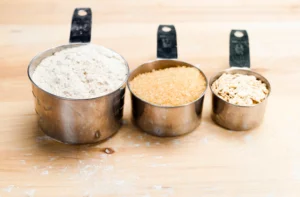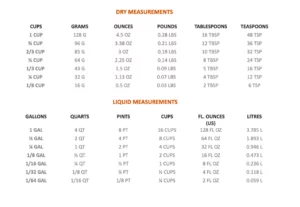How Many Ounces Are in a Cup?

I was in the middle of Christmas baking when my kitchen scale stopped working. Since the recipes I was using were collected from various websites and books on European, Russian and Canadian cuisines, each of them was different. Some were presented in ounces, while others were measured in cups. I could not possibly stop the process, so the conversion of ounces into cups came in handy to rescue my holiday preparations.
Although knowing how to convert ounces into cups and back is a useful skill to have while cooking, there are many factors to consider. One of the main difficulties is that not all measurements are created equal.
No question, both dry and liquid ingredients are measured by using the same terminology and equipment. However, the formulation varies from ingredient to ingredient. For instance, dry products are measured by weight while liquids are by volume.
To make the process of conversion as simple, yet precise as possible, let’s take an in-depth look at all there is you need to know before calculating ounces into cups.

Ounce
“A troy ounce is a unit of measure used for weighing precious metals that dates back to the Middle Ages. Originally used in Troyes, France, one troy ounce is equal to 31.1034768 grams, according to the U.K. Royal Mint.1 One standard ounce (also known as the Avoirdupois ounce) is instead used to weigh other commodities such as sugar and grain, and is slightly less at 28.35 grams,” says Investopedia. However, nowadays the troy ounce is only used to measure precious metals.
At the same time, the avoirdupois ounce, used to measure foods, is equivalent to 28.349 grams or 437.5 grains. The difference (2.751) between a troy ounce and an avoirdupois ounce is not significant when it comes to measuring larger masses, but it matters in smaller equivalents.
Widely used in American Imperial System and British Metric System, the ounce is one of the smallest units. It is used to measure weight, mass and volume. (An interesting fact—the abbreviation “oz” originates from the Italian and Spanish word “Onza.”) And, of course, to make it more complicated than it should be there are two different types of standard ounces.
The importance of proper measurement will be directly reflected in cooked or baked food. For a delicious result, you want to follow the exact recipe, that is why adjustments between cups and ounces are important to know. Without proper conversion, it is easy to get confused and mess up between liquid and dry ingredients.
Fluid Ounce
Fluid ounce measures small volumes and can be abbreviated as “fl oz”. If you are measuring water, cooking oil, milk or any other liquid, it is the unit you will be using.
Equipment (liquid measuring cups):
Liquid measuring cups can be made of plastic, glass or even metal and can be used to measure ounces, cups or even millilitres. Keep in mind that not every measuring cup is the same. British and American cups and ounces use different measuring systems. Hence, it depends on what country you live in (or which website you took the recipe from). The United States uses the imperial system (1 US cup = 240 ml). The UK and many other countries, Canada included, use the metric system (1 UK cup = 250 ml).
Here is a quick example of fluid ounces and cups comparison:
1 cup = 8 fluid ounces or 16 tablespoons
¾ cup = 6 fluid ounces or 12 tablespoons
½ cup = 4 fluid ounces or 8 tablespoons
¼ cup = 2 fluid ounces or 4 tablespoons
Dry Ounce
To measure any dry ingredients such as nuts, seeds, flour, sugar and even yogurt that is not particularly considered dry and solid, use dry ounce. To do that you will need to use granulated measuring cups.
Compared to fluid ounces, a cup of dry ingredients contains different ounces and directly depends on the type of the product. For instance,
1 cup of flour = 4 ¼ ounces
1 cup of chocolate chips = 6 ounces
1 cup of brown sugar = 7.5 ounces
1 cup of butter = 8 ounces
Although comparing dry and liquid ounces might sound confusing, think of it this way. One cup equals 8 fluid ounces. That is firm. At the same time, dry ingredients vary in their weight. You can either use this universal chart, save it on your phone and use it as a guide while cooking or keep the scale at a reach.